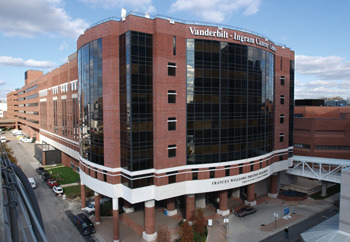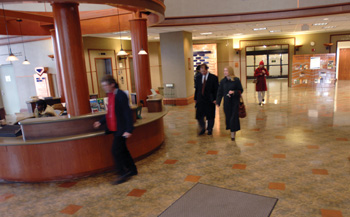
The Vanderbilt-Ingram Cancer Center is embarking on an ambitious plan to renovate and expand its clinic space. (photo by Anne Rayner)
Vanderbilt-Ingram set to expand clinic space

The Preston building lobby will become the main patient entrance. (photo by Dana Johnson)

When renovations are complete, the Infusion Center’s capacity will double. (photo by Dana Johnson
When the dust settles on a new renovation project involving Vanderbilt-Ingram's Henry-Joyce Cancer Clinic, waiting room space and exam rooms will nearly double to help meet the needs of an ever-increasing number of cancer patients in Middle Tennessee and beyond.
With approximately 52,000 outpatient visits in the last fiscal year, adding more space to handle the influx was inevitable.
“The numbers have skyrocketed by about 60 percent since 2002,” said David Johnson, M.D., deputy director of Vanderbilt-Ingram. “They have leveled off a bit, but only because there is a limit to what we can physically do. We can't fit in any more people.”
The estimated $15 million renovation plan is set to begin in May and take about 18 months. The current space of 58,000 square feet will double to 116,000 square feet once the work is done. The changes will take place in several stages, so the business of seeing and treating patients can continue through the renovation process.
In the first phase, the second floor of The Vanderbilt Clinic (TVC), where Otolaryngology was once located, will be slightly redesigned to be used for cancer exam rooms. The current exam rooms in the Cancer Clinic will move up to that second floor space for an interim period. Once vacated, the current Cancer Clinic space will be gutted and re-designed.
During this phase, the main building entrance for patients will be relocated to move people in and out of the Preston Building entrance off Pierce Avenue. Patients will no longer enter the clinic from the TVC entrance by the Outpatient Pharmacy.
In the second phase of the project, cancer care will move back down to a newly designed clinic and the old space on the second floor of TVC will be renovated to become the new infusion area for cancer treatment.
The old infusion area will become the new main clinic lobby and waiting area. So patients will walk right from the Preston Lobby to the check-in area of the new clinic and waiting area. The existing skylights will stay in place to brighten the entrance and waiting room. In addition, the new space will have about 100 chairs for patients and loved ones in the waiting area.
“Our patients frequently come with two to three family members or friends who provide support during the cancer treatment journey,” said Carol Eck, R.N., M.B.A. “We want for them to be able to wait in a comfortable and inviting area.”
A Family Resource room will be conveniently located off the waiting area where patients and family members will be able to access many types of information regarding cancer care and resources available for before, during and after treatment, Eck added.
The new infusion area on the second floor will include 46 rooms with a mixture of chairs and stretchers and 40 chairs in the waiting room. In addition, many of the treatment rooms will have windows. The new space will include some private rooms, a family break and dining area, and an IV pharmacy in the center of the unit. The infusion area will also feature a team concept, grouping patients in clusters based on their diagnosis or treatment needs.
“This expansion will allow our professional cancer care team to meet the needs of our patients and families with more efficiency and effectiveness,” said Jennifer Woods, R.N., M.B.A., manager of the Cancer Patient Care Center.
As part of its efforts to better serve an expanding population of cancer patients, Vanderbilt-Ingram is also engaged in a comprehensive strategic planning process for its clinical care program. Atlanta-based Oncology Solutions, which has worked with hundreds of clients including many academic-based cancer programs, the National Cancer Institute and NCI-designated centers, has been engaged to assist.
Once the renovation work is complete, Vanderbilt-Ingram officials say immune system-compromised cancer patients will have their own elevators and stairwell to get to the infusion area without being exposed to other Vanderbilt patients.
Beth Franklin, a former Vanderbilt-Ingram patient, is now a donor and member of the Board of Overseers. She still visits the clinic for her regular cancer check-ups, but she's here most often now as a caregiver for her mother, who is being treated for lung cancer. Franklin said the plans to expand will make the experience calmer and more efficient for patients and their providers alike.
“I think the plans are great. They are probably overdue. I think it's a great beginning,” said Franklin, a seven-year cancer survivor.
More growth is already on the horizon to keep up with the number of people seeking care. Johnson said outpatient visits are up 35 percent since 2002, more than 90 percent of the care delivered at Vanderbilt-Ingram is on an outpatient basis, and up to half of all cancer patients here come from more than 100 miles away.
Growth in the clinic involves many factors, including the growth of the aging population, but it's also because there are more cancer survivors. In 2006, numbers swelled to more than 10 million living cancer survivors in the United States.
“Once an individual receives a diagnosis of cancer they understandably believe any symptom from that point forward could be a recurrence of their cancer,” Johnson said.
“Consequently, survivors often want to be followed regularly by their oncologist. Some even call us for simple colds. We often end up serving as both oncology and primary care providers.”
Eck added that despite the volume, Vanderbilt-Ingram's outcomes remain strong. “Our survival rates are better regionally and nationally as well. We consistently exceed the national benchmarks,” Eck said.
Johnson added, “Our numbers are not just a little better, they are a lot better than the national average.”
Franklin said she has learned through her own personal experience with cancer how important it is to have a facility like Vanderbilt-Ingram in your own backyard.
“This area is so lucky to have this facility so close to home. We need to give back and see this facility continue to grow for the people of Middle Tennessee.”
Officials at Vanderbilt-Ingram estimate the price tag on the entire upgrade at about $15 million, with $10 million of that money coming from planned philanthropic efforts.













